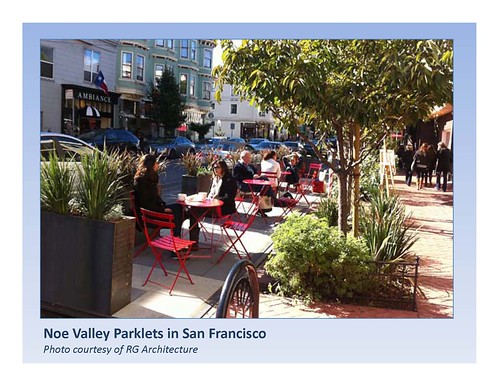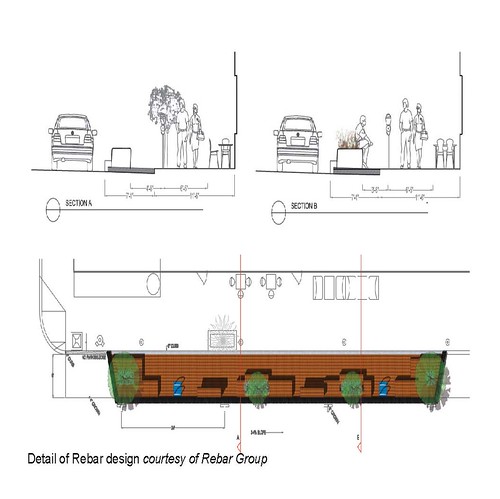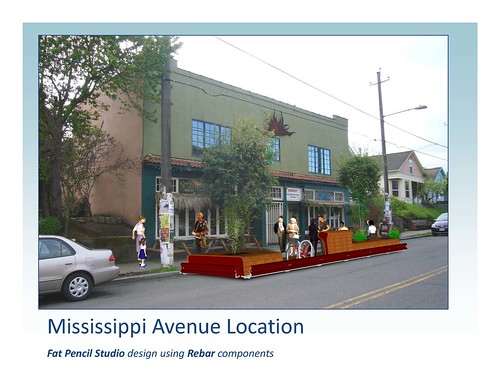Each year I like to feature one presentation from the PSU/PBOT Traffic and Transportation class.
While all the presentations this year were great, Rebecca Hamilton’s objective of creating “parklets” in the parking strips on Mississippi and/or Alberta (PDF, 1.6M) struck a cord chord for me, particularly since this is not a theoretical plan, but something she’s working hard to implement.
I’ve seen this model in European cities, although not at the high level of design that Rebecca shows us in examples from New York City and other cities. As we gradually become less reliant on single-occupancy automobiles, there’s going to be a lot of real estate in our rights-of-way and elsewhere that is currently dedicated to parking that can be put to higher uses. Bike corrals have been a first good step in this process. Let’s hope that Rebecca is successful in taking us several steps further!




19 responses to “2010 Featured Class Presentation”
Concept good , but looks like it is all hard surfaces and free seating for private biz.
If we call it a park it should act like a park.
how about one big lush planter eco-system full of edible fruits/vegs. or a wild play structure for all those pasty soft kids who play video all day , [including 40 year old ones…]
Its pay for seating for businesses. they are the ones who end up fronting the cash.
What’s key for me is the “Seating area can be used by anyone, including business patrons.” I would add, for emphasis, “including but not limited to business patrons.” Without that, this is just more privatizing of public space.
It struck a chord with you, not a cord.
So it did. Community editing always appreciated :-)
Note that Mississippi Avenue between Fremont and Skidmore has a very generous ROW with relatively narrow sidewalks. There is plenty of space for wider sidewalks and curb extensions with bioswales AND an urban renewal district to pay for it. A street design with narrower traffice lanes would “enforce” a 20 mph vehicle speed limit and allow bikes…of which there are many…to mix freely with other vehicles. It would then be easy to trade out some vehicle parking for even more green space, cafe seating, and other worthwhile uses.
Just a thought – how will businesses survive when those who don’t live in Portland can’t visit?
MAX has 2 lines covering roughly 80 square miles of the west side. Public transportation into the city on the bus takes hours *if* TriMet even serves near your area.
Whatever business would pony up cash to reduce customer traffic is a bankrupt one.
LennyAND an urban renewal district to pay for it.
JK Of course that money is taken from schools, social services, fire and police departments and other government services.
Thanks
JK
These would look great on Hawthorne and Belmont as well. And maybe on 21st and 23rd. They could be a real enhancement for businesses all along a “Main Street” retail district if planned correctly.
Of course that money is taken from schools, social services, fire and police departments and other government services.
Of course that’s an oversimplification and not necessarily true either.
Plus, it’s an odd characterization of what is effectively a temporary (but multi-decade) ceiling on future general fund revenue growth and calling it “taking”.
Do you similarly label Oregon’s property tax limitation measures from the 1990’s as “taking” money from schools, etc.?
If so, I’d propose a compromise: Repeal the property tax limitation measures and urban renewal as a concept at the same time. Then, urban infrastructure projects can compete for an expanded pool of general fund dollars just like most other things.
Back to the topic at hand… Last year I had the opportunity to visit a parklet in San Francisco at the intersection of 17th and Castro. See this Google Map for the aerial view. (The “street view” is out-of-date and does not yet show the park.)
The parklet was open to all, and had plantings and tables and chairs spread throughout. The base was still the old paved street. Many people took advantage of the seating for eating, reading a newspaper, drinking coffee, and just people-watching.
Based on previous visits, and I realize this is anecdotal, I’d say there was an uptick in pedestrian traffic and a similar uptick in shoppers. Good for business.
It also served to improve the intersection which was previously over-complicated by too many side streets crossing two major streets.
Here is a Google Street View angle showing the parklet at Market, 17th and Castro.
I hate to disappoint our libertarian critics but if this happens its going to be because of market forces, not social engineering.
Obviously you’re not going to do this on Beaverton-Hillsdale Highway, you’re going to do in area with high pedestrian (and bike – it’s no coincidence that the pilot locations are close to bike corrals) traffic. The experience in New York was the business revenue went UP, not down. Apparently space to actually serve customers was more valuable than space to merely provide access for their cars.
And the city will lose no revenue. Existing PBOT policy (worked out with ZipCar) would require that if a space is removed in a meter district, PBOT collects a fee in lieu of the parking revenue.
JK is correct and Chris Smith/Bob R are wrong. If an urban renewal district is involved, then it has nothing to do with market forces. Measures 5/47 did not take any money away, they just did not allow as much money to be taken from property owners. Urban renewal eliminates the dispersement of property tax money completely for “X” number of years.
re urban renewal. The Interstate Corridor URA is already there, sitting on $300M, so why not spend some on Mississippi? Actually, Missisippi is interesting because so little URA $ has gone there, yet it has boomed. An interesting question for later.
Actually some area residents and businesses fear the gentrification impact of civic improvements with some justice. Making an area more attractive does tend to attract…driving up rents for both residents and retailers. Its a delicate balance.
Note that URAs take only the increase in taxes from an area based on the start date of the district, so the bulk of taxes collected continue to go to schools, the city, etc. It is a perfectly reasonable way to fund targeted public investments in a limited number of city areas that are “underperforming.” Interstate Corridor URA has been bouncing back nicely since the opening of the Yellow Line…not too fast, but not too slow.
To my recollection, the presenter for this project did not say anything about using urban renewal funds.
“Actually, Missisippi is interesting because so little URA $ has gone there, yet it has boomed. An interesting question for later.”
It’s an interesting question now. If “it has boomed”, why spend ANY urban renewal money? If areas can boom without it, that means “market forces” are actually working. Further proof that JK is correct!
Urban renewal eliminates the dispersement of property tax money completely for “X” number of years.
While JK may have oversimplified, your statement is completely false.
Disbursement of property tax money is not “completely” eliminated. Rather, increases in property tax revenues are dedicated to a specific set of purposes within the district boundaries.
If “it has boomed”, why spend ANY urban renewal money? If areas can boom without it, that means “market forces” are actually working.
Your statement contains at least two logical fallacies: One is the assumption that the performance of any one particular area can be applied to all areas, and the other is correlation without proving causation. It would be just as easy (and, in isolation, just as logically incomplete) to state “Look, the Mississippi area is doing well. Portland and Metro’s land use policies work great. Hooray!”
But as Chris mentioned, none of this has anything to do with the actual content of the class presentation.
Actually Mississippi was a city “Target Area” prior to the Interstate Corridor URA and a lot of energy was focused on getting it out of its 90’s funk, which was severe. Of course the Boise & Elliot were that last close in and affordable neighborhoods left as prices in Inner SE and NE escalated. Adidas relocation to Overlook had an impact as well as did the public investment in light rail.
Sorry I got this off on the urban renewal tangent. Bravo to the project creator for proposing better uses for otherwise wasted space in a rapidly developing commercial corridor.
Hi Lenny, and All –
Regarding the use of URA funds for this project, we did apply for public funding through the PDC Interstate Corridor URA Community Livability grant program earlier this year. We did not receive funding, and later had a very good discussion with the PDC regarding their decision. The position of the board was that a parklet would primarily benefit a single business owner instead of the greater neighborhood. The Transportation Subcommittee (to whom we also appealed) felt the same way. We understand and respect the committee’s decision, and thank them for their advice and feedback.
However, we hope to demonstrate that a parklet can be a great asset to the neighborhood as a whole in terms of adding public space, traffic calming, bike parking, and relieving congestion in the pedestrian walkway. We’ll proceed to explore other means of raising the funds for a pilot project through private avenues – perhaps through a Kickstarter grant and cooperation from the sponsoring businesses.
Thank you, Chris, for your interest in this project! It was an honor and privilege to present.